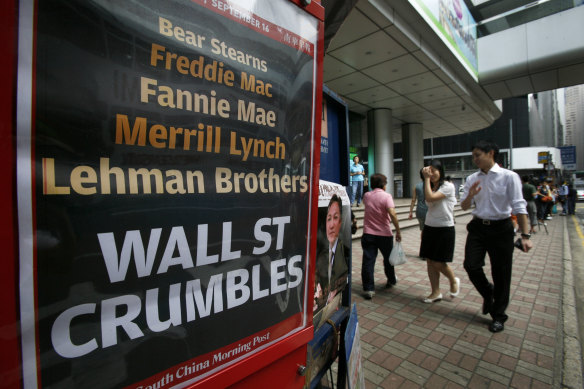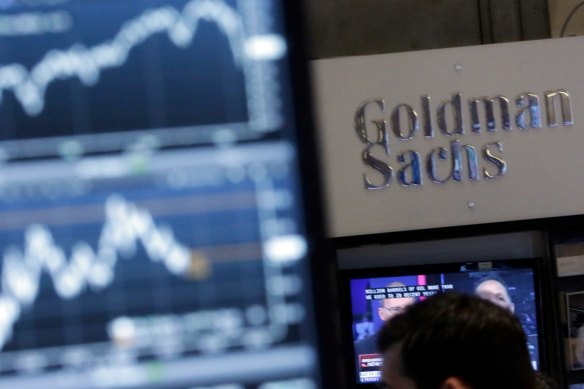The ‘vampire squid’ affair is back on Wall Street’s mind
A decade and a half after the event that raised the issue, and a decade after regulatory action was first mooted, the US Securities and Exchange Commission is again proposing a ban on conflicts of interest for originators of asset-backed securities.
The proposal could restart the broader discussion that occurred in the aftermath of the 2008 financial crisis about the extent to which institutional investors need regulatory protection from the consequences of their own actions and failings.

Exotic variants of securitised mortgages played a major role in the 2008 financial crisis.
In the run-up to the crisis investment banks packaged bundles of sub-prime mortgages and sliced and diced them into tiers of credit quality before on-selling them to investors. The packages generally were known as collateralised debt obligations, or CDOs.
When the sub-prime mortgage market melted down in 2008, so did a number of Wall Street investment banks, commercial banks and other investors that had “long” exposures to that market. Others, however, made billions because they had shorted the market.
One of the more notable winners from the collapse of the sub-prime mortgage market, and arguably the reason the SEC has had such a long interest in implementing a conflict of interest policy, was Goldman Sachs.
The estimated $US4 billion ($5.6 billion) it made from its short position in what were broadly called “structured products” – securitised and sometimes leveraged debt products – contributed to the widespread reusage of journalist Matt Taibbi’s 2010 description of the bank in a Rolling Stone article as “a great vampire squid wrapped around the face of humanity, relentlessly jamming its blood funnel into anything that smells like money.”
Goldman paid $US550 million in 2010 in a settlement with the SEC over a perceived conflict of interest involving its role in the creation and distribution of a sub-prime mortgage product.
A hedge fund client, Paulson & Co, had approached it, seeking a way to short the sub-prime market.
Goldman created one – a synthetic CDO – with input from Paulsen, which helped choose the underlying securities. Goldman then sold the product to institutional investors that wanted long exposures to the sub-prime market without informing them of Paulson’s involvement.
When the crisis hit the investors lost heavily and Paulson won big. Goldman, which had a small exposure to the portfolio, lost $US90 million itself but made billions from the shorts on sub-prime assets held by other parts of the firm.

The SEC’s contention at the time was that Goldman should have told the buyers of the synthetic CDOs of Paulson’s involvement in their design.
Goldman argued – with some validity – that the buyers were supposedly sophisticated investors, with access to detailed information on the underlying securities in the portfolio, who should have known that, as in any securities’ transaction, there were parties on the other side with contrary views and offsetting positions.
Should it have told them specifically of Paulson’s involvement? Perhaps. The SEC certainly thought so and the settlement was, at the time, the largest penalty a Wall Street firm had ever incurred.
In the blizzard of post-crisis reforms to Wall Street and banking regulations and laws, there was a proposal in the Dodd-Frank laws enacted by the US congress in 2010 for a prohibition on participants in asset-backed securitisation engaging in transactions that could represent a conflict of interest with investors.
While the SEC drafted the new rule, which ignited heated discussions with and within the financial sector it was never imposed.
This week it voted to reprise the attempt, saying the proposed rule would prohibit securitisation participants from engaging in “certain transactions” that could incentivise a participant to structure an asset-backed security in a way that would put their interests ahead of investors’.
There would be some exemptions for risk-mitigation hedging activities, bone fide market-making and liquidity provision.
In a fact sheet issued with the proposed rule on Wednesday, the SEC referred to short sales of asset-backed securities and the purchase of credit default swaps or other derivatives that could enable the participant in the securitisation to receive payments in the event of specified credit events as prohibited transactions.
The prohibitions would apply to anyone involved in sponsoring an asset-backed security and would remain in place for a year after the product was sold to investors.
It’s more than arguable that the SEC proposal is unnecessary. The Goldman transaction which was regarded as the exemplar for why such a rule should be imposed involved transactions between sophisticated and consenting institutional investors taking opposing views of the future of a market.
The buyers conducted their own due diligence and should have known, and probably did know, that they were making a high-risk bet on the direction of the market.
They should also have known that the very nature of the synthetic product they were buying meant there were parties on the other side of their transactions taking a symmetrical risk in the opposite direction.
Goldman could, of course, have disclosed Paulson’s involvement in the design of the product and the choice of the underlying securities, which might have made the buyers more wary. It was that omission that left it exposed to the SEC action.
It’ shouldn’t be up to regulators to try to protect institutions or other sophisticated investors from the consequences of their own shortcomings.
Goldman had created a legitimate, albeit exotic, product in response to an approach from a client and then distributed the product to other professional investors, not retail investors who would require greater protections.
That is what financial intermediaries do and, in a broader sense, it is what happens in almost any securities transaction.
If Goldman had itself taken out a short position against the product without informing the investors and/or it had designed a product deliberately designed to fail regardless of the external circumstances, perhaps its actions might be viewed differently.
Transactions involving institutional participants that should have the capacity to analyse the risks associated with an investment proposal being promoted by a financial sponsor should, regardless of the outcomes, have a high barrier for regulatory intervention.
It shouldn’t be up to regulators to try to protect institutions or other sophisticated investors from the consequences of their own shortcomings.
Central to the workings, efficiency and innovativeness of any market – especially when it applies to sophisticated participants – is the concept of caveat emptor, which is in short, the buyer beware principle. Requiring disclosure of real or potential conflicts would be a better approach, if regulatory intervention is indeed necessary, than prohibitions.
The Business Briefing newsletter delivers major stories, exclusive coverage and expert opinion. Sign up to get it every weekday morning.
Most Viewed in Business
Source: Thanks smh.com